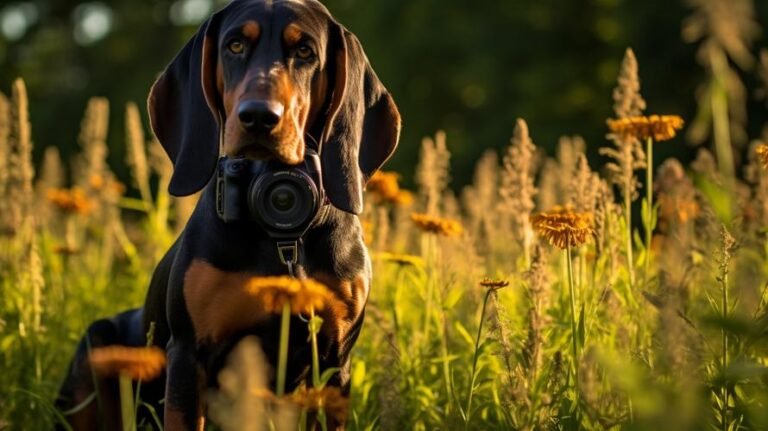To embark on an adventurous culinary journey of our athletic and lovable pooch, the Black and Tan Coonhound, we must dive into the unique history and nature of this breed. Did you know the Black and Tan is considered one of the “original” breeds of coonhounds, bred in the 18th century specifically for tracking and hunting raccoons? That’s right! These clever dogs could follow their prey’s scent, even if the trail was cold, making them excellent hunting partners.
Now, you’re probably thinking, “Great, they’re talented hunters, but what does this have to do with what my Black and Tan Coonhound should eat?” Here’s the thing. The breed’s history influences not only their temperament and activities but also their diet needs.
So, what should a responsible, caring Black and Tan Coonhound worshipping human feed their equally kind, loyal, and hard-working four-legged friend? Well, interestingly enough, it’s not raccoons! The best diet for a Black and Tan Coonhound involves a balanced mix of proteins, carbohydrates, fruits, and vegetables—and yes, certain nutrients can also come from some appropriate table scraps too!
Protein, the Muscular King
Fact: Dogs are carnivores but our domesticated friends are, let’s say, flexible carnivores. Although their ancestors used to devour meat constantly, household canines benefit from balanced diets that include fruits and vegetables. Nevertheless, for a breed as active and muscular as the Black and Tan Coonhound, protein should make up a significant portion of their diet—roughly 18% to 25%.
The protein choice doesn’t always have to be red meat, but can include chicken, turkey, duck, and even some select seafoods like salmon and freshwater trout. If anything, alternating different protein sources is highly recommended as it provides a variety of different nutrients, and makes meals more intriguing for our dog!
Hearty Carbohydrates Provide Power and Pep
Proteins build muscle, but carbohydrates provide energy. Active Black and Tan Coonhounds need a dietary source of quick and easy energy to fuel their daily activities, even if those activities are racing around a backyard rather than chasing raccoons up a tree.
It’s important to differentiate ‘good’ carbohydrates from ‘bad’ carbs here. Good carbohydrates are those that are easy to digest and offer plenty of nutrients. Brown rice, barley, oats, and peas are all examples of excellent carb sources for your Coonhound.
An Emerald Sea of Fruits and Vegetables
Complementing proteins and carbohydrates, fruits and vegetables provide a bonanza of vitamins, minerals, fibers and antioxidants. For instance, sweet potatoes are rich in vitamin A—which is excellent for skin and eye health. On the other hand, cranberries are packed with vitamin C and antioxidants, promoting the immune system and urinary health.
Remember, just like there are good and bad carbs, there are fruits and vegetables that are safe for dogs, and those that are not. Always do your homework before introducing a new food item into your dog’s diet.
“Incredible” Edible Eggs
Eggs are like the Swiss Army Knife of foods — they’re packed with lots of minerals, vitamins, and proteins. Moreover, the amino acids found in eggs are an excellent supplement to your dog’s muscle development.
Most importantly, Your Black and Tan Coonhound will love the taste, and the variety will prevent them from getting bored with their meals. A boiled egg as a weekly treat can do wonders for your Coonhound’s health.
In a Nutshell – Nutritional Balance is Key!
No single food item can provide all the necessary nutrients that an active, intelligent Black and Tan Coonhound needs daily. The most effective feeding strategy is balance and variety, with a lean towards essential proteins, healthy carbohydrates, and a handful of fruits and vegetables.
Remember, each dog is unique. Depending on your dog’s weight, activity levels, and health conditions, the ideal food portions and nutritional needs will vary. As a rule of thumb, strive to make their meals proportionate to their size, age, and activity level.
Hungry for More? Here’s One Last Bite of Knowledge
Now, we’ve talked all about the nutritional categories your dog needs, but what’s the best way to provide them? Commercial dog food, home-cooked meals, raw feeding? How do you choose?
The truth is, there’s no absolute right or wrong answer here, and different experts nurture varying opinions. Whether you choose to buy high-quality commercial dog food, or whip up a homemade meal, or decide on raw feeding— the key thing is to provide the necessary balance of essential nutrients.
Consulting with your vet is always the best way to create a balanced diet plan that caters solely to your dog’s unique nutritional needs. Knowing what your Black and Tan Coonhound needs to consume to maximize their health and live their best life is part of the journey of dog-ownership, and the ultimate display of love for our pooches!



